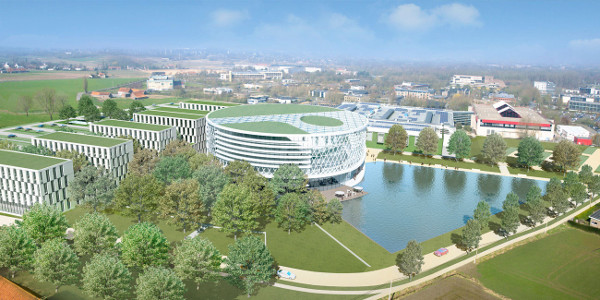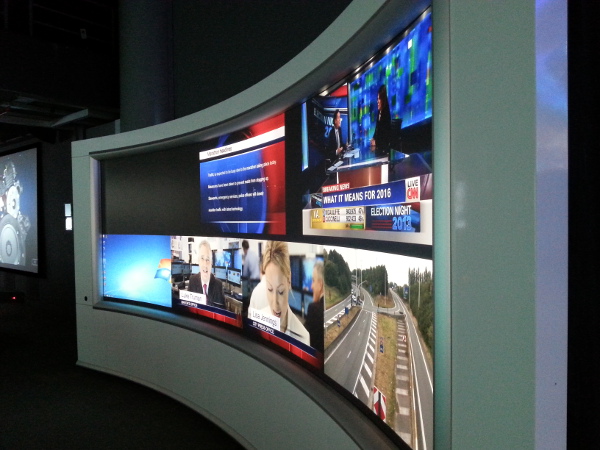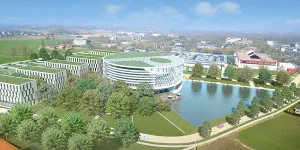I had the opportunity to spend the whole day meeting with many people at Barco’s Kunne facility in Belgium last week. This is a company that is on the move, pushing technology in every AV direction, expanding products and services while spinning off other sectors.

This focusing effort is perhaps best symbolized by the brand new facility it’s building in Kortrijk Belgium that will consolidate all manufacturing and other operations. Move in should start early in 2016.
 Barco’s New Facility Being Built in Kortrijk, Belgium
Barco’s New Facility Being Built in Kortrijk, Belgium
Currently, projector manufacturing is done in Kuune, where I also received a tour of the operation. It is a large facility with all kinds of projectors being built, repaired, tested and shipped from the facility. This will all move to Kortrijk.
The Kortrijk facility currently houses sales and marketing, operations and some additional manufacturing, like LED video walls, and the training and simulation group. This latter group was recently sold to Esterline, with the company buying part of the existing Kortrijk building to continue to house the former Barco employees. Barco will continue to manufacture projectors for this market with the Barco brand while Esterline will focus on being a solutions provider.
From my conversations, it is clear that Barco is “all in” with laser solid state lighting for projectors going forward. Barco is about to roll out its first laser phosphor projectors for the ProAV market and just demonstrated a DCI-compliant prototype at NAB with 18K lumens. Barco’s Product Manager Goran Stojmenovik thinks the company can push laser-phosphor to 30K lumens using the larger 4k DMD chips. This will compete directly with NEC’s laser-phosphor approach for the mainstream theatrical segment. Barco also intends to offer an laser-phosphor retrofit solutions for its B-, C- and S-series projectors. The first pre-installed C-series projectors (2K, 0.98″ DMD with around 20K lumens) is available now with more to come later.
But there is also a big focus on RGB laser sources and projection for bigger screens. Here, Barco’s approach is to integrate the lasers in the projector “head” and separate the laser chiller in an outboard unit, running cooling lines to the projector.
Christie prefers to place the lasers and cooling in a separate box running RGB laser light to the projector head over fiberoptics. The merits or demerits of these approaches are sure to be debated in the Digital Cinema panel at Display Summit.
In the Barco RGB laser approach, users can opt to purchase a 6p (6 primaries for spectral 3D separation) solutions at 45K and 60K lumens (which needs 2 chiller units) or at 22K and 30K lumens (with one chiller unit). These projectors are VERY expensive, but Barco wants to make a Total Cost of Ownership (TCO) argument noting the long life of the laser sources (30K hours to 80% of initial brightness) and reduced power consumption (40% of comparable Xenon lamp). Barco’s Laser Guy, Bill Beck, posted a nice blog that explains the cost savings and efficiency benefits of an RGB laser solution at: http://www.barco.com/en/News/Post/2015/4/17/On-the-road-to-CinemaCon-episode-3. Here, he compares the cost of the the laser projector to two Xenon-based projectors and their lamp consumables, plus saving in power and labor to make a TCO argument.
The company also has a joint venture in China with the China Film Group and it is pushing its new Barco Escape 3-screen theatrical solution as well.
The 6p solutions are needed for 3D and they are also better at speckle reduction than a 3p solution (because of the spectral broadening with two lasers near each primary). 3p and 6p solutions can both achieve the DCI P3 color gamut, but to reach the 2020 color gamut requires a 3p solution with additional speckle reduction techniques (like vibrating the screen). There is now some debate about revising the UHD specification for the primaries and tolerance for the 2020 color gamut specification that focuses on some of the practical issues of commercialization (to be discussed in Wide Color Gamut session at Display Summit).
Wide color gamuts are not just desirable for TVs. Companies doing car design for example, want the wider color pallet to show colors that can’t be displayed in 709 or some other color pallets. Barco’s Yoav Nir noted that the company has developed a rear-projection solution with an RGB 4k laser projector that car designers love because of the wide color gamut, but also the high resolution and contrast (2D and 3D) and improved uniformity. “They are finally able to see the color eggplant, for example”, explained Nir.
Nir also showed me a screen Barco developed that is much better at reducing ghost images that result in high contrast areas due to internal scattering within the screen. It also helps with speckle reduction without vibrating the screen.
 Curved rear projection display that blends 5 portrait projectors
Curved rear projection display that blends 5 portrait projectors
In LED video walls, Barco started with an incubator company called Live Dots that has done so well that it is now being integrated into the regular Barco infrastructure. Solutions have expanded beyond LEDs to now include LCD video wall offerings as well. To support playout, Barco has a 10 Gbps solution to deliver uncompressed content over fiber with zero latency.
Advertising applications are huge and Barco’s Media Service is trying to develop an ECPM (efficient cost per thousand) pricing model by using cameras and algorithms to identify people’s age and gender and deliver ads targeted at the viewing demographic. – Chris Chinnock

